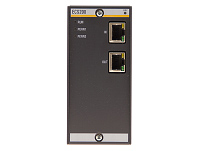ECS200 EtherCAT Slave
The EtherCAT slave module ECS200 allows connecting a M1 controller system as slave device to an external EtherCAT network. The goal is to use the M1 to control an autonomous intelligent subsystem within a complex system or machine. The application programs (PLC, C/C++) have full access to the incoming and outgoing cyclic process data via the MIO and SVI interfaces and via the process image.
The slave state and the connection state can be recognized by the user programs. Thus, emergency situations like network problems or failures of the external EtherCAT Master can be handled individually in dedicated emergency routines. The application programs at the slave station can be accurately synchronized to the external EtherCAT bus for closed-loop control operations. The execution cycle of the user programs can be maintained also in emergency situations. Distributed Clocks are supported.
Amount and size of the incoming and outgoing cyclic data are configured on the slave station, and then a dedicated ESI file is generated to configure the master system. The PDO mapping can be defined statically or can be created by the EC Master dynamically. As EtherCAT slave, the M1 is a module device with a static object dictionary that does not need to be further configured by the master.
Diagnostic is supported by several LED indications on the module, by log messages and by a monitor in the Bachmann SolutionCenter.
- 2 EtherCAT Ports IN, OUT
- Max. 700 Bytes cyclic data for Rx und Tx each
- Bus interval 125 µs to 10 ms
- Distributed Clock
- User programs can be synchronised to EtherCAT
- Connection- and network state visible for user programs
- Behavior in case of network problems configurable
- LED for display of slave state
- Error-LEDs for In- and Out-Port
- Galvanic isolation from the system
- Condensation-proof coldclimate design on request


